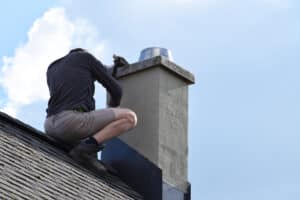A balanced attic ventilation system is a critical part of roof health. Creating an equal distribution of intake and exhaust vents can help control temperature and moisture in the attic. Balanced attic ventilation is essential because it reduces energy costs, extends the life of your roof, and keeps your indoor temperature comfortable.
Understanding how roof ventilation works and what contributes to balanced roof ventilation can help you better cool down your space, save money, and prevent roof damage all year long.
What is Roof Ventilation?
Roof ventilation works on the principle that warm air naturally rises. When heated air from your living space rises to the attic, it can damage the roof sheathing and the roofing material if the attic is not adequately ventilated. It can also cause moisture buildup, leading to rot, mold, mildew, and ineffective insulation.
How Does it Work?
Balanced roof ventilation allows air to continuously flow through the attic space to prevent the above problems. It works by pushing cool air through the attic and allowing the heat to escape through the vents. When air rises, it creates a high-pressure point in the attic. Escaping hot air is called exhaust. However, this hot air needs an inlet for cooler, low-pressure air to escape from the attic. The cool air that enters the attic is known as intake.
There are two primary types of roof ventilation systems:
- Intake vents: These vents can be harder to recognize; they are located at the lowest part of the roof under the eaves. They work by pulling cool air from the outside and forcing warm air to exit through the exhaust vents.
- Exhaust vents: These vents are located at the peak of the roof so hot air can escape the attic. They are installed underneath the shingles for a seamless look. Common exhaust vents include ridge vents, roof lovers, wind turbines, power attic ventilators, and gable louvers.
Proper roof ventilation requires a 50/50 balance between exhaust and intake vents to keep warm air out of the attic. Imbalanced ventilation can create negative pressure in the attic, pulling out conditioned air from the home via the ceiling, lighting fixtures, wall cracks, and joints in the framing. This can result in higher heating bills, lost energy, and a less comfortable environment. Simply put, the amount of exhaust ventilation should not exceed the amount of intake ventilation.
Roof ventilation only works when air flows. Airflow is created by two methods:
- Mechanical (active): Feature an electric or solar-powered fan that turns on when the temperature in the attic reaches a set limit and runs until the temperature drops.
- Natural (passive): Makes use of natural forces such as thermal buoyancy and wind to encourage airflow through your attic.
Benefits of Balanced Roof Ventilation
- Extends the Life of Your Roof. Well-balanced roof ventilation is critical to extend the life of your roof. A poorly ventilated attic means your attic temperature can be nearly double the temperature outside. Balanced ventilation will allow hot air to escape, keeping your attic and roof cooler.
- Reduces Energy Costs. Balance attic ventilation allows the hot air to escape, keeping the attic cooler and reducing the workload on your air conditioner. This can also save money on utility costs.
- Keeps Your Home More Comfortable. Poorly vented roofs cause indoor temperature extremes. During the warmer months, you may notice upstairs rooms are warmer. It may even get to a point where the rooms are uncomfortably hot during the day.
Ridge Vents: Everything You Need to Know
A ridge vent is an exhaust vent installed at the peak and running the length of your roof. Usually made from aluminum or a mesh-type material, a ridge vent is installed underneath the final layer of shingles to give it a low-profile design.
When installing a ridge vent, a slot is first cut in the roof deck. The ridge vent is then placed more like an upside-down book on the roof’s peak in a manner that creates negative pressure to allow warm, humid air from the attic to escape outside.
A ridge vent has two main components:
- External baffle: Creates external pressure to pull out hot air from the attic.
- Weather filter: Prevents debris, rodents, insects, and wind-driven rain and snow from entering your attic.
Ridge vents work in tandem with the soffit vent to create a smooth flow of air in and out of your attic. They’re highly efficient and cost-effective roof ventilation systems. They help prevent common roofing system problems, including ice dams, mold, and premature aging.
We Can Help You Vent
Adam Vaillancourt Roofing is the contractor you can trust for top-tier roofing services in the Southern New Hampshire and Northern Massachusetts areas. We use the best roof ventilation products on the market today, along with the recommended installation techniques to ensure your attic has adequate and balanced ventilation. Contact us today to discuss your needs and to request a free estimate.




